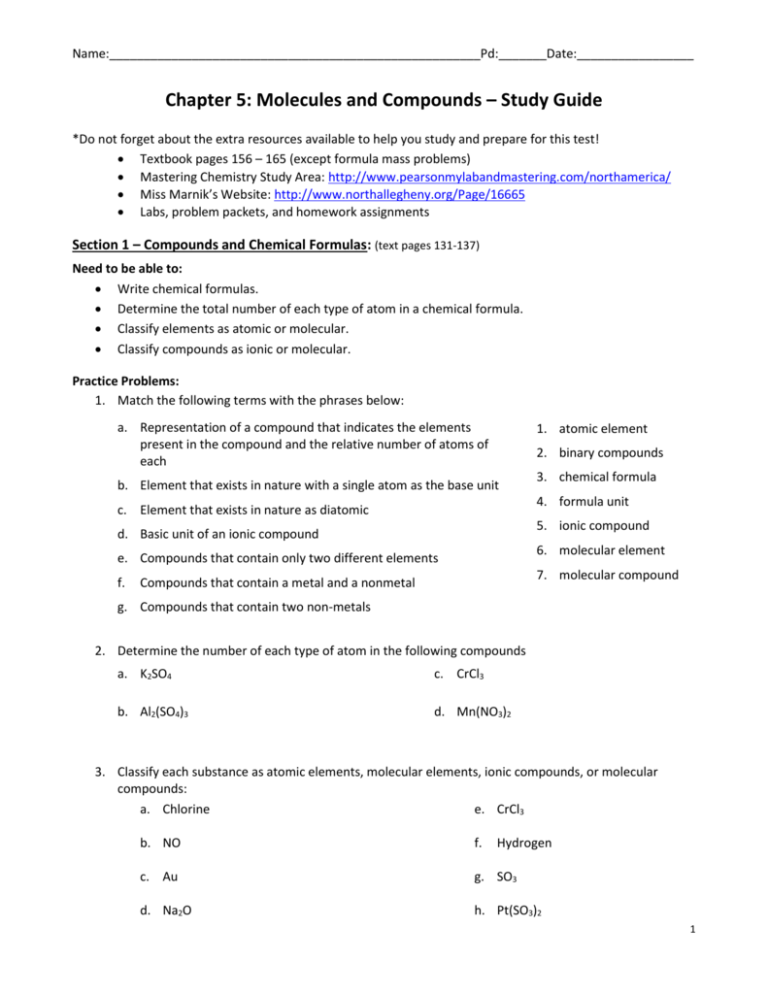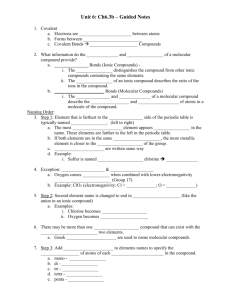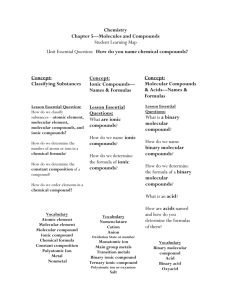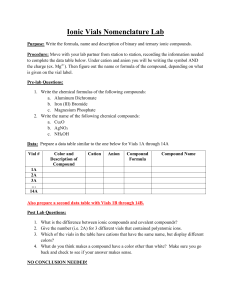Chapter 5 Study Guide
advertisement

Name:______________________________________________________Pd:_______Date:_________________ Chapter 5: Molecules and Compounds – Study Guide *Do not forget about the extra resources available to help you study and prepare for this test! Textbook pages 156 – 165 (except formula mass problems) Mastering Chemistry Study Area: http://www.pearsonmylabandmastering.com/northamerica/ Miss Marnik’s Website: http://www.northallegheny.org/Page/16665 Labs, problem packets, and homework assignments Section 1 – Compounds and Chemical Formulas: (text pages 131-137) Need to be able to: Write chemical formulas. Determine the total number of each type of atom in a chemical formula. Classify elements as atomic or molecular. Classify compounds as ionic or molecular. Practice Problems: 1. Match the following terms with the phrases below: a. Representation of a compound that indicates the elements present in the compound and the relative number of atoms of each 1. atomic element 2. binary compounds b. Element that exists in nature with a single atom as the base unit 4. formula unit c. Element that exists in nature as diatomic 5. ionic compound d. Basic unit of an ionic compound 6. molecular element e. Compounds that contain only two different elements f. 3. chemical formula 7. molecular compound Compounds that contain a metal and a nonmetal g. Compounds that contain two non-metals 2. Determine the number of each type of atom in the following compounds: a. K2SO4 c. CrCl3 b. Al2(SO4)3 d. Mn(NO3)2 3. Classify each substance as atomic elements, molecular elements, ionic compounds, or molecular compounds: a. Chlorine e. CrCl3 b. NO f. Hydrogen c. Au g. SO3 d. Na2O h. Pt(SO3)2 1 4. Give the empirical formula that corresponds to each molecular formula: a. C2H6 c. C4H6O2 b. N2O4 d. CO2 Section 2 – Writing Formulas for Ionic Compounds: (text pages 138-140) Need to be able to: Write formulas for ionic compounds. Practice Problems 5. Write a formula for the ionic compounds the forms from each pair of elements: a. aluminum and oxygen d. calcium and iodine b. beryllium and iodine e. lead (II) and fluorine c. calcium and sulfur f. copper (I) and oxygen 6. Write a formula for each ionic compound: a. silver nitrate e. lead (II) chromate b. sodium sulfate f. c. potassium hydrogen sulfate g. lithium hypochlorite d. potassium permanganate h. copper (II) nitrate calcium fluoride Sections 3 & 4 – Naming Compounds: (text pages 140-150) Need to be able to: Distinguish between common and systematic names for compounds. Name binary ionic compounds containing a metal that forms only one type of ion. Name binary ionic compounds containing a metal that forms more than one type of ion. Name ionic compounds containing a polyatomic ion. Name molecular compounds. Name binary acids. Name oxyacids containing an oxyanion ending in -ate. Name oxyacids containing an oxyanion ending in -ite. 2 Practice Problems: 7. Ionic Compounds: If the name of the compound is given, write the formula. If the formula of the compound is given, write the name. a. calcium nitrite j. b. BaSO4 k. cesium hydrogen sulfate c. silver acetate l. d. SrSO3 m. ammonium chloride e. nickel(II) phosphate n. Ca(ClO3)2 f. Na2CO3 o. rubidium cyanide g. LiHCO3 p. copper(II) sulfate h. calcium hydroxide q. CuCl i. r. manganese(II) silicate HCN Ti(OH)4 iron(II) arsenate 8. Molecular Compounds: If the name of the compound is given, write the formula. If the formula of the compound is given, write the name. a. CF4 i. difluorine octachloride b. N2O5 j. tribromine nonatelluride c. CS2 k. XeF4 d. SO3 l. e. P4O8 m. carbon dioxide f. n. trinitrogen hexabromide iodine tribromide SI4 g. chlorine dioxide o. diiodine heptaselenide h. sulfur hexafluoride p. dihydrogen monoxide 3 9. Acids: If the name of the compound is given, write the formula. If the formula of the compound is given, write the name. a. hydrocyanic acid i. H2S(aq) b. dichromic acid j. acetic acid c. hydrobromic acid k. sulfurous acid d. sulfuric acid l. e. H2SiO3(aq) m. hydroselenic acid f. n. carbonic acid HF(aq) perchloric acid g. H3PO3(aq) o. HClO(aq) h. H2CO3(aq) p. HClO2(aq) 10. All Compounds: Identify each as ionic, molecular, or acidic. If the formula of the compound is given, write the name. a. cadmium nitrate k. sulfur hexafluoride b. chromate ion l. c. dinitrogen monoxide m. hydrogen peroxide d. potassium bromide n. carbonate ion e. nitrous acid o. BaO (aq) f. p. HClO2 (aq) H3PO4(aq) sulfuric acid g. PCl3 (aq) q. SrSO3(aq) h. V2O5 (s) r. i. HClO4(aq) s. CBr4 (aq) j. BaSO4 (s) t. acetic acid calcium hydroxide 4 *Extra Practice* You do not need to complete these as a part of the study guide. They are for your own practice if you feel they are necessary. The answers will be posted with the study guide. Identify each compound as ionic, molecular, or acidic. If the formula of the compound is given, write the name. 1. potassium iodide 15. Na2CO3 (aq) 2. AgNO3 (aq) 16. Cu3P (aq) 3. barium nitrate 17. HI (aq) 4. Na2SO3 (aq) 18. lead(II) acetate 5. potassium carbonate 19. hydrogen peroxide 6. sodium nitrate 20. potassium biphosphate 7. barium acetate 21. Ba(OH)2 (s) 8. CO (g) 22. Fe3(PO4)2 (aq) 9. dicarbon octafluoride 23. aluminum sulfate 10. P4O10 (s) 24. calcium hydroxide 11. Si3N4 (g) 25. tin(II) oxide 12. Cl2S7 (s) 26. aluminum hydrogen carbonate 13. NBr5 (l) 27. sodium perchlorate 14. phosphorus trichloride 28. copper(I) dichromate 5 29. potassium selenide 46. ammonium phosphate 30. ZnS (s) 47. Be(ClO)2 (aq) 31. sodium hydrogen phosphate 48. aluminum oxalate 32. Fe(ClO)2 (aq) 49. rubidium dichromate 33. copper(II) nitrate 50. KHSO3 (aq) 34. potassium hypochlorite 51. NH4OH (aq) 35. iron(III) chromate 52. lead(II) nitrate 36. Ag2SO4 (s) 53. sodium carbonate 37. PI3 (l) 54. H2C2O4(aq) 38. disulfur trioxide 55. H3P(aq) 39. PCl5 (l) 56. HMnO4(aq) 40. diiodine dichloride 57. hydrochloric acid 41. dinitrogen monoxide 58. chromic acid 42. I4O9 (s) 59. phosphoric acid 43. H2O (l) 60. HCl(g) 44. P2S4 (l) 61. nitrous acid 45. N2O4 (g) 62. iron (III) tartrate 6






